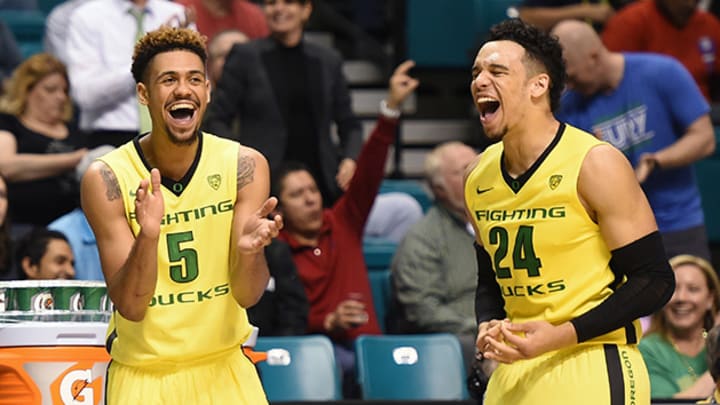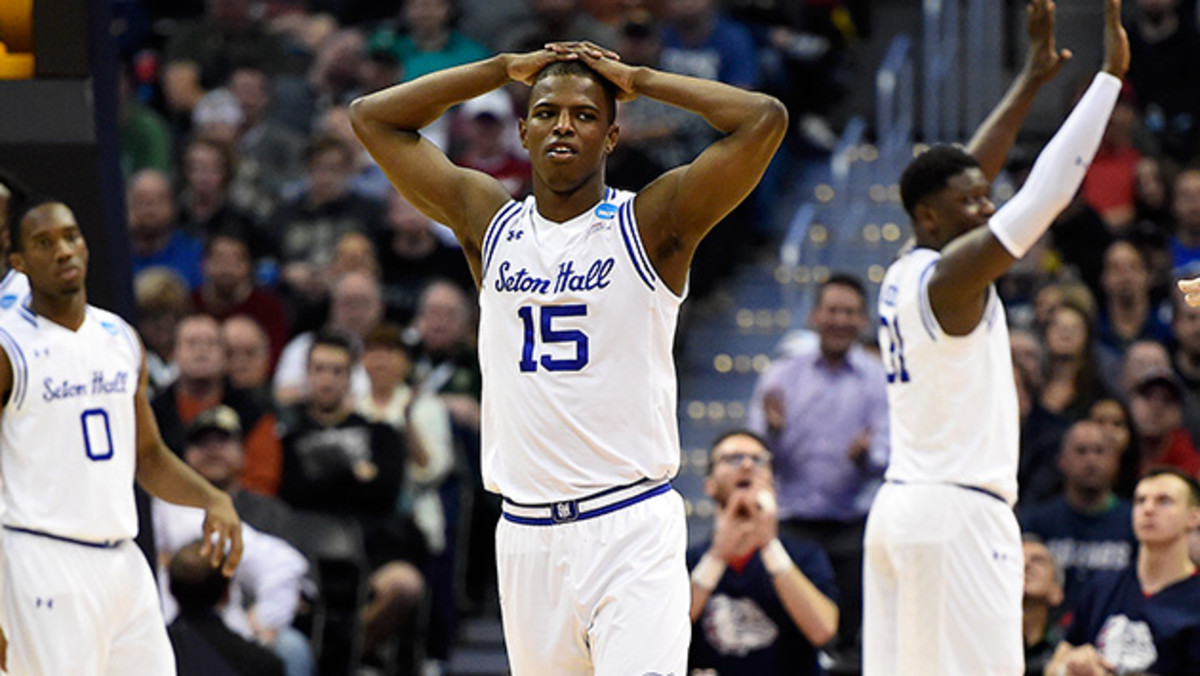NBA draft deadline winners & losers

Get all of Chris Johnson’s columns as soon as they’re published. Download the new Sports Illustrated app (iOS or Android) and personalize your experience by following your favorite teams and SI writers.
An NCAA rule change this year allowed college basketball players more flexibility in determining whether they will turn pro. The withdrawal deadline for early-entry prospects in the NBA draft was pushed back to 10 days after the combine, extending the waiting period for some programs to learn whether or not they’ll return key pieces from last season. With the deadline passing on Wednesday, now is a good time to identify some winners and losers. This analysis is more concerned with developments announced closer to the withdrawal date and largely ignores predictable moves such as Ben Simmons leaving LSU after one season.
Winners
Wisconsin: Wisconsin risked regressing in coach Greg Gard’s first full season at the helm had Nigel Hayes elected to stay in the draft. Alas, Hayes is returning, as are his team-leading 89.9 minutes percentage and 6.5 fouls drawn per 40 minutes mark. Hayes’s scoring efficiency took a tumble as he shouldered a larger workload last season, but the Badgers will welcome him back with open arms to lead a push for the Big Ten title alongside guard Bronson Koenig and big man Ethan Happ. For Wisconsin fans, last season may have been disappointing in comparison to its 2014–15 campaign, which ended with an appearance in the title game, but the Badgers came within five points of a trip to the Elite Eight this year. And with Hayes back, Wisconsin should plan on playing in the second weekend again.
• MORE: How the NCAA can improve the draft process for its players
Villanova: The last time you saw the Wildcats on a basketball court, they were piling on top of Kris Jenkins in celebration of maybe the greatest shot in NCAA tournament history. It’s not crazy to think the Wildcats could finish next season the same way. O.K., maybe not with another Jenkins game-winner, but don’t count out Villanova in the national title race now that Josh Hart has decided to return for his senior season. In 2015-16 Hart led all returning Big East players in minutes logged, Effective Field Goal percentage and Win Shares, he’s a good rebounder for his size and he can hurt defenses from both sides of the arc. Hart’s presence alone would have made the Wildcats a formidable challenger in the Big East next season, but he’ll have lots of help—including Jenkins, guards Jalen Brunson and Phil Booth and forwards Mikal Bridges and Darryl Reynolds.
Maryland: Few teams had more at stake heading into the deadline than Maryland. If sophomore guard Melo Trimble stayed in the draft, the Terrapins would be losing all five starters from last season’s Sweet 16 team, and their relevancy in the national conversation would have hinged on Jaylen Brantley and Jared Nickens creating another viral dance craze. SI.com encourages Brantley and Nickens to keep dancing, but with Trimble in the fold, Maryland could be interesting for basketball reasons in 2016–17. Though Trimble endured the opposite of a “sophomore leap” last season—his three-point shooting dipped and he got to the free-throw line less often—he flashed star potential as a freshman. The Terrapins probably lost too much around Trimble to push Michigan State, Wisconsin and Indiana at the top of the Big Ten, but his return provides cause to believe they won’t fall too far.

Oregon: In 2015–16 Oregon won 31 games, claimed the Pac-12 regular season and conference tournament titles, reached the Sweet 16 and made easy work of a blueblood (Duke) before running into Buddy Hield and Oklahoma. With Dylan Brooks and Tyler Dorsey opting to withdraw from the draft, the Ducks have a shot to get back to the Elite Eight in 2016–17. Dorsey hit 40.6% of his threes as a freshman last season, and when he wasn’t inserted into silly controversies over game-ending shots, Brooks was driving Oregon to a top-15 adjusted offensive efficiency ranking with dependable two-point scoring, foul-drawing and free-throw shooting. Arizona probably will be better next season given freshman guard Allonzo Trier’s return and its loaded recruiting class, but with Brooks, Dorsey and Chris Boucher in tow, the Ducks should be favored to win the Pac-12 again.
College basketball players: The aforementioned rule change achieved its intended purpose. When the NCAA announced the change in January, the college governing body said in a release, “Students competing in men’s basketball now have a better opportunity to assess their likelihood of success in the NBA without jeopardizing their college eligibility.” This is a good thing for college basketball players, and it showed this year. Some of them, such as Providence’s Ben Bentil, performed well in the combine, received encouraging feedback about their stock and subsequently elected to turn pro. Others who declared for the draft, perhaps sensing their stock was lower than they’d hoped, decided to come back. The upshot is that players were able to make more informed decisions about their professional futures.
Losers
Providence: Unfortunately for Providence, Bentil’s decision means it will enter next season without the Big East’s top scorer. Bentil was one of the most improved players in the country in 2015–16; had he continued on that growth curve, he could have kept the Friars in solid standing in a Big East that could feature three top-20 teams in Villanova, Xavier and Creighton. And Bentil wasn’t even Providence’s most costly roster departure: it’s losing junior guard Kris Dunn, a potential top-five pick in the draft. With Dunn and Bentil gone, coach Ed Cooley will need to rebuild around returning forwards Rodney Bullock and Jalen Lindsey, Indian Hills Community College transfer (and former Indiana player) Emmitt Holt and a recruiting class featuring four-star point guard Maliek White, three-star small forward Alpha Diallo and three-star center Kalif Young.
For coaches of stay-or-go players, no choice but to wait
USC: The Trojans ended last season with a disappointing loss in the first round of the tourney, but they entered the off-season with a rosy outlook: There was plenty of talent coming back to a team that won more than 20 games for the first time since 2008–09. Now? It seems unlikely USC can keep pace with Oregon and Arizona in the Pac-12. Forward Nikola Jovanovic and guard Julian Jacobs chose to stay in the draft, depriving the Trojans’ of two of their three leading scorers and their top rebounder. Trying to recreate their production would have been a difficult task in and of itself, but USC also watched four players (Katin Reinhardt, Darion Clark, Malik Martin and Malik Marquetti) transfer out of the program this spring. The Trojans have enough returning talent to remain a tough out in conference play, but their 2016–17 ceiling is lower than it appeared two months ago.
Louisville: Louisville is bringing back more than enough talent to earn an invitation to the NCAAs, but it would have been better equipped to challenge Duke and Virginia in the ACC had Chinanu Onuaku decided to return to school. The 6'10' forward was the Cardinals’ best rebounder and shot-blocker, and he made major strides from his freshman season to his sophomore season. Without him, Louisville will lean on sophomore Ray Spalding and upperclassmen Mangok Mathiang, Anas Mahmoud, Matz Stockman and Jaylen Johnson to anchor its frontcourt. The good news for the Cardinals? Their perimeter rotation should be in pretty good shape. Guards Donovan Mitchell and Quentin Snider can prop up an offense losing top scorers Damion Lee and Trey Lewis, and coach Rick Pitino has coaxed a top-five adjusted defensive efficiency mark from his teams in six consecutive seasons.

Seton Hall: If Trimble’s decision was the most beneficial to any team’s outlook for 2016–17, Whitehead’s may have been the most damaging. The sophomore was the Pirates’ engine last season, an offensive force who elevated coach Kevin Willard from preseason hot seat fixture to conference co-coach of the year. During Big East play Whitehead shot 42.6% from behind the three-point line, drew 6.1 fouls per 40 minutes and assisted on 35.5% of his team’s baskets, all of which ranked in the top five in the conference. How will the Pirates move forward without him? Their forward rotation should hold up well, given the returns of junior starters Angel Delgado, Desi Rodriguez and Ismael Sanogo. And the backcourt, while worse off without Whitehead, could support a second consecutive tourney bid if freshmen Myles Powell and Eron Gordon can provide enough scoring and playmaking around junior Khadeen Carrington.
Mississippi State: When Malik Newman, a former five-star recruit out of in-state Callaway High, picked Mississippi State over Kentucky, Kansas and Ole Miss in April 2015, it was viewed as a massive recruiting win for a new coach (Ben Howland) trying to jump-start a middling program. A little more than a year later, Newman is considering leaving the Bulldogs—but not for the NBA. Multiple reports this week said that while Newman has opted to pull out of the draft, he’s exploring the possibility of a transfer. Newman didn’t live up to his recruiting hype last season; he posted a sub-100 Offensive Rating in conference play and logged a lower percentage of minutes than fellow freshman Quinndary Weatherspoon. Still, if Newman stays in Starkville, he could serve as one of the top scoring threats on a team with proven perimeter pieces (Weatherspoon and I.J. Ready) and a top-10 recruiting class on the way.
